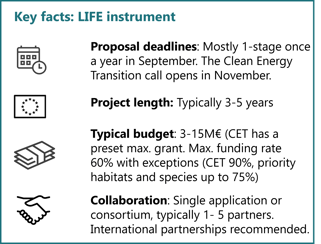LIFE programme: multiple opportunities for environmental and climate actions
The LIFE funding instrument is one of the largest public funding programmes in Europe fully dedicated to the environment, nature and climate. The instrument is annually launching calls totalling approx. 500M€ to implement best practices, develop, demonstrate and promote innovative techniques, methods and approaches, accommodating an extremely wide range of topics and sectors. What’s in it for you? Our LIFE programme expert Mikko Tiira helps us navigate the intricacies of LIFE and get the updated insights into the instrument.
With his solid expertise on the LIFE instrument in various roles before joining Spinverse, Senior Consultant Mikko Tiira is indeed our go-to expert to enlighten us on the LIFE programme and what kind of funding calls are opening in spring 2024 for companies seeking to launch forward-looking environmental and climate initiatives.
Successful LIFE actions are all about environmental impact, sustainability, replicability and transferability
Managed by CINEA (European Climate, Infrastructure and Environment Executive Agency), the LIFE programme boasts a budget of 5.45B€ for 2021-2027, constituting a 100% contribution to the objectives of the European Green Deal. With its four programmes (nature and biodiversity, circular economy and quality of life, climate change mitigation and adaptation, and clean energy transition), LIFE contributes to an astonishingly wide scale of topics. LIFE programme offers a unique breeding ground for bold and innovative ideas across different, even unexpected, disciplines and sectors. For instance, LIFE funding has brought together art and environmental protection. Mikko lists examples of areas where LIFE funding could be applied: technology solutions or approaches to waste management, smart buildings, water management, energy efficiency, decarbonizing transport, circular economy, safe chemicals, reducing GHG emissions…and then some!
Mikko explains that the LIFE programme contributes to creating new knowledge, demonstration and upscaling of practices, and application of best practices with focus on environmental and/or climate impact, sustainability, replication and transferability.
Measurable impacts are key to a successful funding proposal. In addition, the project may have substantial socio-economic impacts in the participating countries and beyond. Further, the action can make a significant technological impact, introduce new kind of expertise or practices, ways of operation, operation models or change in policies and regulations. ‘Sustainability’ refers to the long-term nature of funded actions and their end results: how can the outcomes of the action be maintained after the project has been completed? At the same time, the project must include concrete measures during and after the project for replication and transfer of the outcomes to new regions, countries or sectors.
Mikko points out: “When considering the eligibility of your project proposal, in addition to environmental and climate impacts you need to keep the requirements on the project’s impact in your mind: Can this what I am planning to do be done elsewhere and will it benefit others — even in the whole of EU? Will my action change mindsets, opinions, approaches, or even policies and legislation?”

Useful tips from Mikko
Mikko explains that the LIFE programme has not set limits to the number of partners or countries that can apply for funding together, but typically there are 3-5 partners collaborating on a project. Also, single applicant projects are possible provided the key stakeholders for the value chain are engaged with the project. Balanced project consortium covers the value chain and also acknowledges various kinds of partners such as private and public. Mikko recommends seeking international collaboration as it will promote transferability and replicability to other countries. International actions increase the chances of securing funding when the action can be tested and validated in another country.
As for budget, there are no maximum budgets set by LIFE, but typically, the total budgets are in the range of 3-15M€. The reason behind the flexible scale is that the challenges seeking solutions are of different magnitudes. Successful projects demonstrate “value for money”, high potential and conceivable, direct results and impacts. The project proposals also need to demonstrate a well thought-out plan to communicate and disseminate the outcomes of the actions and exploitation of the results.
Clean Energy Transition aims to boost the uptake of techniques and building up necessary skills
The Clean Energy Transition funding call is somewhat different to other LIFE subprogrammes as it has preset maximum budgets for each topic ranging between 1 to 2.5M€ with a significant maximum EU funding rate of 95%. Moreover, the call topics have also clearly defined foreseen outcomes. For the other programmes, it is up to the applicant to provide the outcomes matching the programme topics.
Mikko sums up: “The LIFE programme may have a reputation of being difficult to approach and conceive, but I find this claim a myth. Putting together a winning proposal is of course a labour-intensive undertaking, but once you have carefully defined your approach, the LIFE programme offers a myriad of options with a lot of flexibility. We are happy to offer our understanding and expertise to our customers in identifying the most successful approach for their project. Upon a successful funding decision, our experts can also continue the collaboration in managing the funded project.”
Get in touch with Mikko:

Mikko Tiira, Senior Consultant
e-mail: mikko.tiira@spinverse.com
tel. +358 40 1696 646
More information: https://cinea.ec.europa.eu/programmes/life_en
